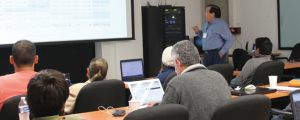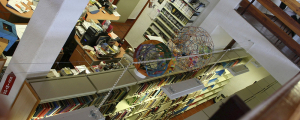Noticimat 38
Actividades del 31 al 4 de noviembre 2022
Seminarios

Seminario de Topología (CIMAT Mérida)
Lunes 31
Hora: 10:00 (CDMX)
Ponente: Jaime Calles (IM-UNAM)
Título: La sucesión espectral de Eilenberg-Moore y la imagen de la cohomología bajo el funtor T
______________________________________________________________________________________________________________________________________
Seminario de Estudiantes
Lunes 31
Hora: 12:30 (CDMX)
Lugar: Salón G001
Ponente: Rafael Correa Morales (CIMAT)
Título: Teorema de descomposición para el espacio de medidas reales aditivas definidas en un álgebras
Resumen: Al trabajar con un espacio vectorial E siempre resulta útil descomponerlo como suma directa de otros espacios con una estructura conocida. Esto se usa para conocer propiedades de E a partir de la información conocida de los espacios que lo componen. Cuando el espacio vectorial E es ordenado, existe un método para descomponerlo a partir de cierto tipo de subespacios. Esto es, para cada subespacio B ⊆ E con cierta propiedad, existe un subespacio B^d ⊆ E tal que E = B ⊕ B^d. El objetivo de esta plática es describir las propiedades bajo las cuales estos resultados son válidos, y aplicarlos al espacio de medidas reales aditivas M(A, R). Esto nos conducirá a una prueba directa del teorema de Yosida-Hewitt y el teorema de Lebesgue-Radón-Nikodym.
______________________________________________________________________________________________________________________________________
Lunes 31
Hora: 13:00 CDMX)
Lugar: Salón G101
Ponente: Gerardo Pérez Suárez (CIMAT)
Título: Probabilidad de explosión de SPDEs con ruido browniano fraccionario
Esta ecuación describe el proceso de combustión de materiales sólidos. Debido al crecimiento
superlineal del término u(t, x) 1+β , las soluciones pueden explotar en tiempo finito, es decir, las soluciones pueden divergir a infinito en un tiempo finito. En esta presentación estudiaremos la ecuación de Fujita perturbada por un ruido browniano fraccionario BH con parámetro de Hurst H > 1/3. Primeramente, introduciremos la noción de solución débil de esta ecuación y demostraremos su existencia y unicidad. Posteriormente, estimaremos la probabilidad de que esta solución explote en tiempo finito. Para esto se estudiarán los funcionales exponenciales de BH, es decir, las variables aleatorias de la forma
![]()
Esta presentación se basará en trabajo en conjunto con José Alfredo López Mimbela.
______________________________________________________________________________________________________________________________________
Seminario Maya Junior de Aritmética SMJA (CIMAT Mérida)
Lunes 31
Hora: 17:00 (CDMX)
Ponente: Víctor Daniel Reyes García (Universidad Juárez Autónoma de Tabasco)
Título: Modelos neuronales p-ádicos con transformaciones no lineales.
Resumen: Las primeras aplicaciones de las matemáticas no arquimedianas para modelar la cognición se dirigieron a una formalización rigurosa del consciente-inconsciente de la psicología. Esta formalización se basó en el uso de herramientas y técnicas extraídas de la teoría de sistemas dinámicos. La principal novedad es una representación en forma de árbol del espacio de los estados mentales. En esta plática describiremos estos modelos así como su comportamiento dinámico mediante transformaciones lineales f(x)= xᵐ+c y algunos de los resultados más relevantes.
______________________________________________________________________________________________________________________________________
Seminario de Computación
Martes 01
Hora: 15:00 (CDMX)
Lugar: Salón G101
Ponente: Aline Normoyle (Bryn Mawr College)
Título: How avatar controls affect perceived body ownership and performance in virtual and augmented reality.
Resumen: Virtual and augmented reality can provide more immersive 3D experiences than traditional screen-based games. However, the design of the player’s avatar can
greatly impact how immersive the experience can feel to the user. In this talk, I will describe several experiments involving naturalistic grasping controls in a virtual environment. We look at the effect of mismatches between the user’s and avatar’s hand sizes. We implement and compare two grasping approaches: one based on accurate hand tracking using a real-time optical motion capture system and one based on joystick controllers. We also look at how our findings carry over to a video game from simpler experiments based on repetitive tasks. To conclude the talk, I will talk about in-progress work to study how the method used to control the avatar might affect the player’s feelings of agency and control in mobile augmented reality.
______________________________________________________________________________________________________________________________________
Seminario Conjunto de Estadística y Ciencia de Datos
Miércoles 02
Hora: 12:30 (CDMX)
Ponente: Nico Kuschinski (PUC, Santiago, Chile)
Título: Bernstein Grid Uniform Copula Models: Inference Method for a Rich Class of Copula Functions
Resumen: Copula models provide great flexibility in modeling relationships between random variables. For inference to take full advantage of this flexibility, one needs appropriately rich families of copula functions, capable of approximating any copula. One such family is the family of Bernstein copulas, which are a variety of multivariate Bernstein polynomial, and which has been shown to be dense in the space of continuous copula functions. Bernstein copulas have been used for inference before, but only using likelihood-free approximation methods. We observe a fact about the geometry of the parameter space of Bernstein copulas and note that it is closely related to a different class of copula known as grid-uniform copulas. Based on this relationship, we propose a Bayesian model based on Bernstein copulas and an automatic MCMC algorithm capable of performing full posterior inference on the copula function.
______________________________________________________________________________________________________________________________________
GEOTOP-A
Viernes 04
Hora: 10:00 (CDMX)
Ponente: Marc Lackenby (University of Oxford)
Título: Knot theory and machine learning.
Resumen: Knot theory is divided into several subfields. One of these is hyperbolic knot theory, which is focused on the hyperbolic structure that exists on many knot complements. Another branch of knot theory is concerned with invariants that have connections to 4-manifolds, for example the knot signature and Heegaard Floer homology. In my talk, I will describe a new relationship between these two fields that was discovered with the aid of machine learning. Specifically, we show that the knot signature can be estimated surprisingly accurately in terms of hyperbolic invariants. We introduce a new real-valued invariant called the natural slope of a hyperbolic knot in the 3-sphere, which is defined in terms of its cusp geometry. Our main result is that twice the knot signature and the natural slope differ by at most a constant times the hyperbolic volume divided by the cube of the injectivity radius. This theorem has applications to Dehn surgery and to 4-ball genus. We will also present a refined version of the inequality where the upper bound is a linear function of the volume, and the slope is corrected by terms corresponding to short geodesics that have odd linking number with the knot. My talk will outline the proofs of these results, as well as describing the role that machine learning played in their discovery.
This is joint work with Alex Davies, Andras Juhasz, and Nenad Tomasev.
______________________________________________________________________________________________________________________________________
Eventos

The 15th Annual ACM SIGGRAPH Conference on Motion, Interaction and Games
November 3-5
The goal of the Motion, Interaction and Games conference is to bring together researchers from this variety of fields to present their most recent results, to initiate collaborations, and to contribute to the establishment of the research area. The conference will consist of regular paper sessions, poster presentations, and as well as presentations by a selection of internationally renowned speakers in all areas related to interactive systems and simulation. The conference includes entertaining cultural and social events that foster casual and friendly interactions among the participants.
More details: https://mig2022.cs.purdue.edu/
______________________________________________________________________________________________________________________________________
Otras Actividades
Charla Especial- Dr. Alex Preciado
Martes 01
Hora: 12:30
Lugar: Salón D604
Enlace de Transmisión: https://bluejeans.com/740333303
Charla dirigida tanto a estudiantes de licenciatura como investigadores y técnicos académicos.
Title: “From Black Hole Physics to Data Engineering: How to Successfully Transition your Career beyond Academia”
Abstract: Is it possible to successfully transition to industry from academia and back? In this talk we will discuss what and why industries are looking for scientific talent and how to successfully navigate the path from academia to organizations with a data-driven culture. Examples of of how machine learning, data science and data engineering can add value to the private sector will be discussed, with emphasis on what specific tools and skills are required for a successful transition.
https://alex-preciado.github.
______________________________________________________________________________________________________________________________________
Visitantes
Por motivo de visita académica para tratar temas de problemas inversos en ecuaciones diferenciales – aplicación a identificación de acuíferos, próximamente del 21 al 23 de diciembre nos acompañarán en nuestro Centro Liliana Guadalupe Salvador y Hugo Alberto Flores Arguedas ambos de Arkansas State University, campus Querétaro.
Anfitrión: Miguel Ángel Moreles Vázquez
______________________________________________________________________________________________________________________________________
Divulgación

Lunes 31 al Jueves 03
Valentina Muñoz, Dennis Olvera, Carmen Mares y Alma Ortega ofrecerán clases de matemáticas a las niños y niñas de la Escuela Primaria “Amado Nervo”, ubicado en la colonia Valenciana, Guanajuato, Gto.
Horario 8:30 a 10:30 am.
______________________________________________________________________________________________________________________________________
Lunes 31
Se recibirá una visita de estudiantes de la Universidad Tecnológica del Suroeste de Guanajuato, con el objetivo de conocer los proyectos que realizan en el centro de investigación así como los requisitos necesarios para desarrollarse en el área de TICs. A continuación el programa de la visita:
10:00 Recorridopor las instalaciones del CIMAT
10:30 Dr. Francisco Sánchez Sánchez “Divisiones libres deenvidia”
11:40 Dr. Johan VanHorebeek “Aplicaciones de Ciencia de Datos”
______________________________________________________________________________________________________________________________________



